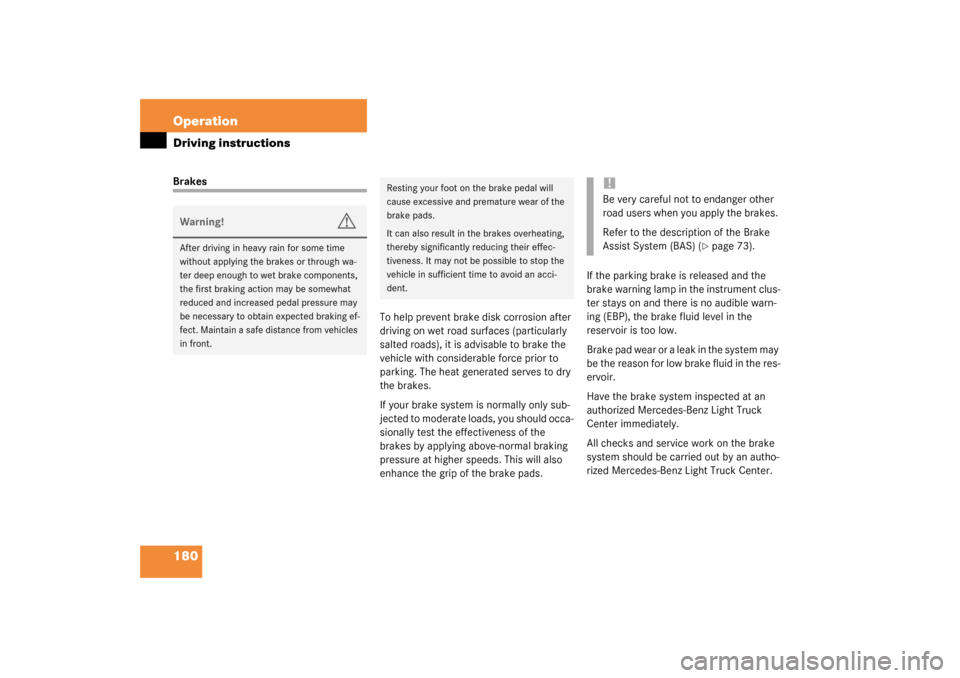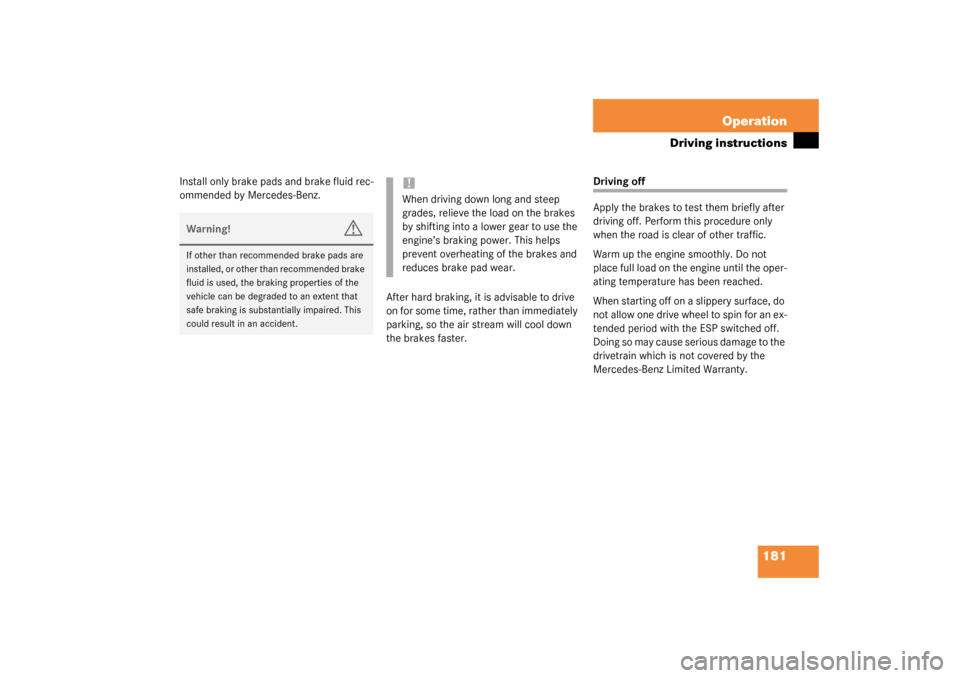Page 74 of 321

74 Safety and SecurityDriving and safety systems
LOW RANGE 4-ETS
During off-road driving a special low range
system for the 4-ETS is operational with
transmission in LOW RANGE mode.
More information can be found in the
“Practical hints” section (
�page 224) and
(
�page 226).
EBP
The EBP enhances braking effectiveness
by allowing the rear brakes to supply a
greater proportion of the braking effort
without a loss of vehicle stability.
Warning!
G
When you see the 4-ETS/ESP-warning lamp v
flashing in the speedometer dial, then
proceed as follows:
�
While driving off, apply as little throttle
as possible.
�
While driving ease up on the accelera-
tor.
�
Adapt your speed and driving style to
the prevailing road conditions.
Failure to observe these guidelines could
cause the vehicle to skid.
The 4-ETS cannot prevent accidents result-
ing from excessive speed.
!The engine must be shut off when�
the parking brake is being tested on
a brake test dynamometer.
�
the vehicle is being towed with the
front axle raised.
Otherwise, the 4-ETS will engage the
brakes and seriously damage the brake
system.
iIf the yellow 4-ETS malfunction indica-
tor lamp
{
comes on while the
4-ETS/ESP warning lamp
v
flashes,
the electronic traction system is being
switched off temporarily to prevent
overheating of the drive wheel brakes.
Page 180 of 321

180 OperationDriving instructionsBrakes
To help prevent brake disk corrosion after
driving on wet road surfaces (particularly
salted roads), it is advisable to brake the
vehicle with considerable force prior to
parking. The heat generated serves to dry
the brakes.
If your brake system is normally only sub-
jected to moderate loads, you should occa-
sionally test the effectiveness of the
brakes by applying above-normal braking
pressure at higher speeds. This will also
enhance the grip of the brake pads.If the parking brake is released and the
brake warning lamp in the instrument clus-
ter stays on and there is no audible warn-
ing (EBP), the brake fluid level in the
reservoir is too low.
Brake pad wear or a leak in the system may
be the reason for low brake fluid in the res-
ervoir.
Have the brake system inspected at an
authorized Mercedes-Benz Light Truck
Center immediately.
All checks and service work on the brake
system should be carried out by an autho-
rized Mercedes-Benz Light Truck Center.Warning!
G
After driving in heavy rain for some time
without applying the brakes or through wa-
ter deep enough to wet brake components,
the first braking action may be somewhat
reduced and increased pedal pressure may
be necessary to obtain expected braking ef-
fect. Maintain a safe distance from vehicles
in front.
Resting your foot on the brake pedal will
cause excessive and premature wear of the
brake pads.
It can also result in the brakes overheating,
thereby significantly reducing their effec-
tiveness. It may not be possible to stop the
vehicle in sufficient time to avoid an acci-
dent.
!Be very careful not to endanger other
road users when you apply the brakes.
Refer to the description of the Brake
Assist System (BAS) (
�page 73).
Page 181 of 321

181 Operation
Driving instructions
Install only brake pads and brake fluid rec-
ommended by Mercedes-Benz.
After hard braking, it is advisable to drive
on for some time, rather than immediately
parking, so the air stream will cool down
the brakes faster.
Driving off
Apply the brakes to test them briefly after
driving off. Perform this procedure only
when the road is clear of other traffic.
Warm up the engine smoothly. Do not
place full load on the engine until the oper-
ating temperature has been reached.
When starting off on a slippery surface, do
not allow one drive wheel to spin for an ex-
tended period with the ESP switched off.
Doing so may cause serious damage to the
drivetrain which is not covered by the
Mercedes-Benz Limited Warranty.
Warning!
G
If other than recommended brake pads are
installed, or other than recommended brake
fluid is used, the braking properties of the
vehicle can be degraded to an extent that
safe braking is substantially impaired. This
could result in an accident.
!When driving down long and steep
grades, relieve the load on the brakes
by shifting into a lower gear to use the
engine’s braking power. This helps
prevent overheating of the brakes and
reduces brake pad wear.
Page 195 of 321

195 Operation
Driving instructions
Adjust the mirrors to permit unobstructed
view beyond rear of trailer.�
If the trailer has electric brakes, start
your vehicle and trailer moving slowly,
and then apply only the trailer brake
controller by hand to be sure the
brakes are working properly.
�
Always secure items in the trailer to
prevent load shifts while driving.
�
When towing a trailer, check occasion-
ally to be sure that the load is secure,
and that lighting and trailer brakes (if
so equipped) are functioning properly.
�
Take into consideration that when tow-
ing a trailer, the handling characteris-
tics are different and less stable from
those when operating the vehicle with-
out a trailer.
It is important to avoid sudden maneu-
vers.
�
The vehicle and trailer combination is
heavier, and therefore is limited in ac-
celeration and climbing ability, and re-
quires longer stopping distances.
I t i s m o r e p r o n e t o r e a c t i n g t o s i d e w i n d
gusts, and requires more sensitive
steering input.
�
If possible, do not brake abruptly, but
rather engage the brake slightly at first
to permit the trailer to activate its
brake. Then increase the braking force.
�
If the transmission hunts between
gears on inclines, manually shift to a
lower gear (select 4, 3, 2 or 1).
A lower gear and reduction of speed re-
duces the chance of engine overload-
ing and / or overheating.
�
On very steep inclines, not manageable
with selector lever in position1, switch
transfer case to LOW RANGE mode
(�page 118).
�
When going down a long hill, shift into
a lower gear and use the engine’s brak-
ing effect.
Avoid riding the brakes, thus overheat-
ing the vehicle and trailer brakes.
!If the trailer should begin to sway, re-
duce the vehicle’s speed and use the
brake controller by hand to straighten
out the vehicle and trailer.
In no case should you attempt to
straighten out the tow vehicle and trail-
er by increasing the speed or over-
steering and stepping on the brakes.
Page 230 of 321

230 Practical hintsWhat to do if …Problem
Possible cause
Suggested solution
/
The yellow coolant warning lamp
lights up when the engine is run-
ning.
The coolant is to hot.
The coolant level is too low.
�
Stop as soon as possible and allow
the engine and coolant to cool down.
�
Check the coolant level and add
coolant if necessary (
�page 206).
If the warning lamp lights up frequently, there
is a leak in the cooling system.
�
Have the cooling system checked by
an authorized Mercedes-Benz Light
Truck Center.
The coolant temperature gauge is above
248 °F (120 °C).
The coolant level is too low.
�
Stop as soon as possible and allow
the engine and coolant to cool down.
�
Add coolant to prevent engine from
overheating (
�page 206).
If the coolant level is correct, the electrical
radiator fan may be broken.
�
If the coolant temperature is below
the red zone, drive on to the nearest
authorized Mercedes-Benz Light
Truck Center.
Avoid high engine loads (e.g. driving
uphill) and stop-and-go driving.